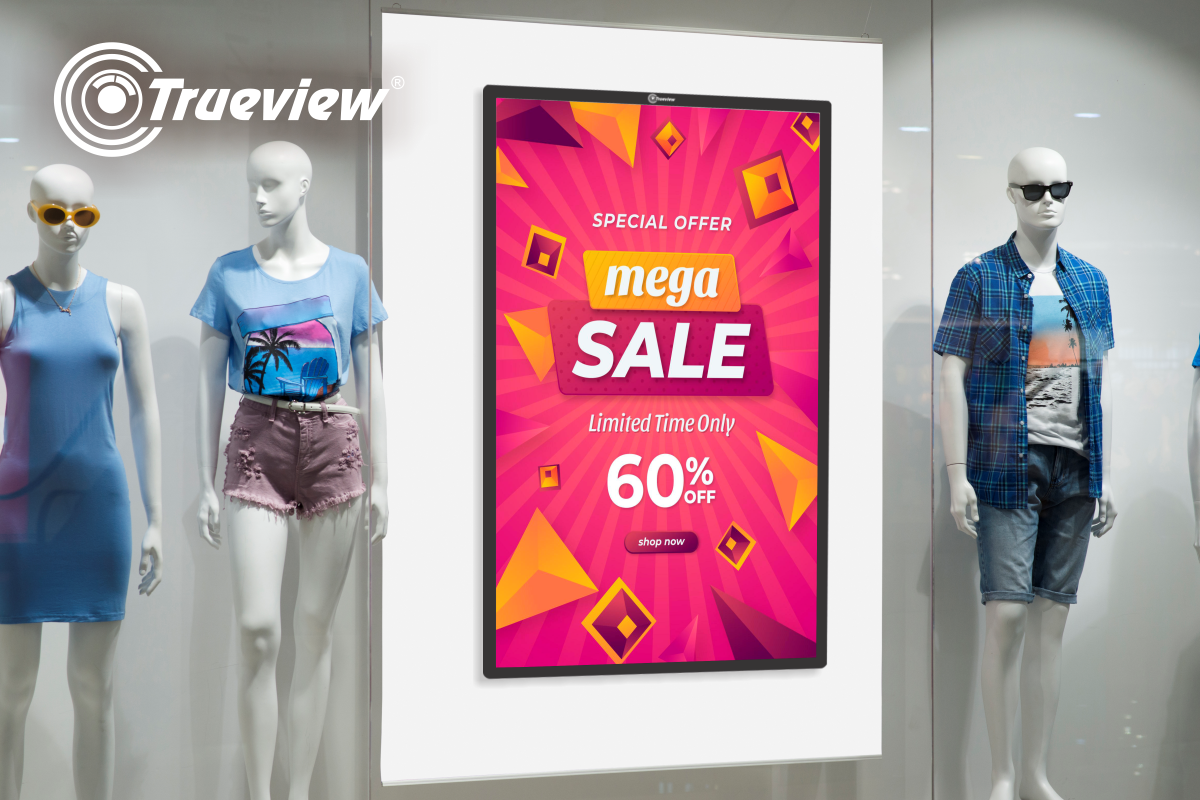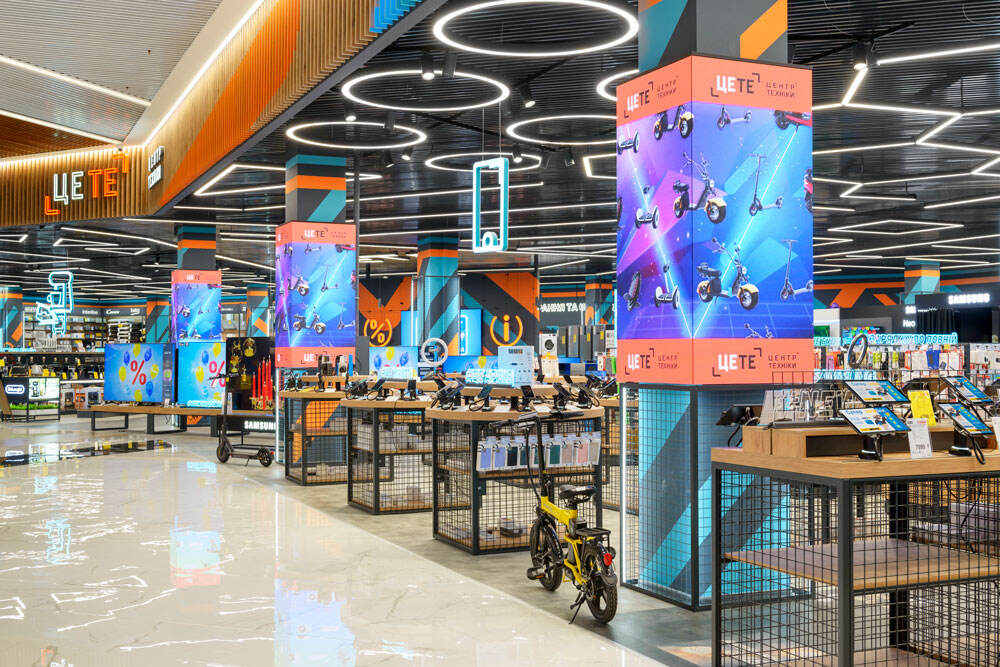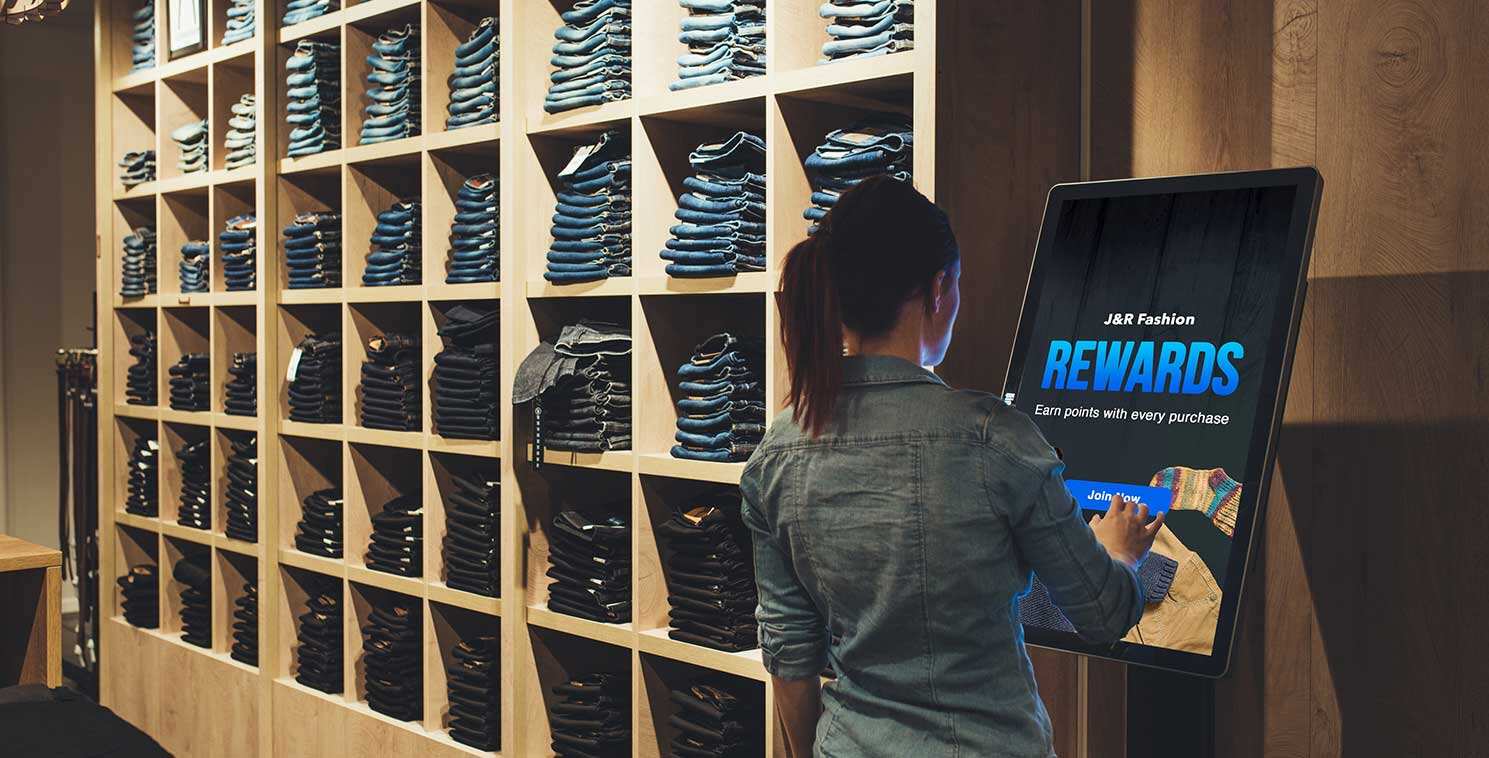Làm thế nào ngành bán lẻ có thể sử dụng quảng cáo bằng biển báo kỹ thuật số để tăng doanh số?

Với sự ra đời của thời đại kỹ thuật số, ngành bán lẻ đang phải đối mặt với những thay đổi chưa từng có. Các mô hình quảng cáo truyền thống đang dần được thay thế bởi các bảng hiệu kỹ thuật số sáng tạo. Thông qua màn hình hiển thị năng động, tương tác và các khuyến nghị cá nhân, biển báo kỹ thuật số không chỉ là một công cụ để hiển thị quảng cáo, mà còn là một vũ khí mạnh mẽ để thu hút khách hàng, nâng cao trải nghiệm người dùng và tăng cường ảnh hưởng của thương hiệu. Đối với các nhà bán lẻ, cách sử dụng biển báo kỹ thuật số quảng cáo để tăng doanh số đã trở thành một chủ đề quan trọng.
Trong bài viết này, chúng tôi sẽ khám phá cách ngành bán lẻ có thể tối ưu hóa chiến lược tiếp thị thông qua các hệ thống biển báo quảng cáo thông minh, thu hút nhiều khách hàng hơn, tăng tỷ lệ chuyển đổi bán hàng và cải thiện trải nghiệm mua sắm tổng thể.
# DigitalSignage # DigitalSignageSystem # RetailIndustry # SalesIncrease # DigitalSignageHardware # DigitalSignageSoftware # ContentManagementSystem # CMS
Liên hệ với chúng tôi để biết thêm chi tiết
Email: [email protected]
Trang web chính thức: https://www.uhopestar.com/
WhatsApp: +86-13501581295
#DataAnalysisTools #InteractiveDigitalSignage #TouchScreen #HighResolutionDisplays #BrandExposure #PromotionalAdvertising #PersonalizedRecommendations #Thiết kế và hoạt động của công ty
Quảng cáo biển báo kỹ thuật số: một công cụ tiếp thị mới nổi cho ngành bán lẻ
Digital signage là một hệ thống hiển thị nội dung quảng cáo, thông tin quảng cáo hoặc trải nghiệm tương tác thông qua màn hình hiển thị (chẳng hạn như màn hình LED, màn hình cảm ứng, v.v.). Họ có thể cập nhật nội dung quảng cáo trong thời gian thực, đưa ra các khuyến nghị cá nhân và tương tác với khách hàng. Đối với các nhà bán lẻ, biển báo kỹ thuật số không chỉ là một phương tiện để hiển thị thương hiệu và sản phẩm, mà còn là một công cụ hiệu quả để đạt được tiếp thị chính xác và tăng sự tham gia của khách hàng.
#Tương tác khách hàng #TryVirtualOn #AdContentDesign #BrandConsistency #AdPlacement #HighTrafficAreas #AdLayout #AdEffectiveness #ContentUpdates #AdConversionRate
1. Quảng cáo động thời gian thực: Tăng tiếp xúc sản phẩm
Trong các cửa hàng bán lẻ, biển báo kỹ thuật số có thể giúp các thương nhân hiển thị thông tin sản phẩm khác nhau thông qua quảng cáo năng động. Mặc dù các áp phích và biểu ngữ giấy truyền thống có thể truyền tải thông tin, nhưng chúng không thể được cập nhật trong thời gian thực, cũng không thể điều chỉnh nội dung theo nhu cầu của khách hàng hoặc xu hướng thị trường. Hệ thống biển báo kỹ thuật số có thể dễ dàng đạt được điều này, cải thiện tính linh hoạt và tính chất thời gian thực của nội dung quảng cáo.
Ví dụ, các trung tâm mua sắm có thể điều chỉnh nội dung quảng cáo theo các khoảng thời gian hoặc ngày lễ khác nhau hoặc cập nhật thông tin quảng cáo dựa trên hàng tồn kho thời gian thực. Bằng cách hiển thị năng động các sản phẩm giảm giá, ưu đãi đặc biệt, v.v., nó có thể thu hút sự chú ý của khách hàng trong thời gian, tăng tiếp xúc sản phẩm và do đó thúc đẩy doanh số.
Vụ: Một trung tâm mua sắm lớn đã sử dụng biển báo kỹ thuật số để hiển thị các chương trình khuyến mãi theo mùa. Bằng cách điều chỉnh nội dung quảng cáo theo thời gian thực, nó đã thu hút nhiều khách hàng hơn để mua sắm và tăng doanh số cuối năm.
#CustomerEngagement #CustomerBehaviorAnalysis #SmartAdvertising #AdOptimization #BigDataAnalysis #InteractiveAdFeatures #SystemMaintenance #RealTimeUpdates #Thiết kế và hoạt động của các công ty
2. Trải nghiệm tương tác: cải thiện sự tham gia của khách hàng
So với quảng cáo truyền thống, một lợi thế đáng kể của biển báo kỹ thuật số là tính tương tác của nó. Các nhà bán lẻ có thể tương tác với khách hàng thông qua các công nghệ như màn hình cảm ứng, nhận dạng giọng nói và thậm chí nhận dạng khuôn mặt. Sự tương tác này không chỉ cải thiện sự tham gia của khách hàng, mà còn thu thập dữ liệu sở thích của khách hàng và đưa ra các khuyến nghị cá nhân.
Ví dụ, Khi khách hàng chạm vào màn hình quảng cáo, họ có thể nhận được thông tin chi tiết, tùy chọn màu sắc, giá cả, tình trạng hàng tồn kho, vv của sản phẩm, và thậm chí có thể mua hàng trực tiếp trên màn hình. Thông qua tương tác, khách hàng có thể nhận được thông tin chính xác hơn, đồng thời cải thiện sự thuận tiện và trải nghiệm mua hàng.
Vụ: Một thương hiệu mỹ phẩm nổi tiếng đã lắp đặt màn hình kỹ thuật số tương tác trong các cửa hàng bán lẻ của mình. Khách hàng có thể chạm vào màn hình và chọn các mỹ phẩm mà họ quan tâm. Hệ thống đề nghị các sản phẩm phù hợp dựa trên loại da, màu da và các dữ liệu khác của khách hàng, do đó cải thiện tỷ lệ chuyển đổi.

#AdStrategy
3. Các khuyến nghị cá nhân: Đáp ứng chính xác nhu cầu của khách hàng
Digital signage không chỉ có thể hiển thị quảng cáo tĩnh, mà còn đưa ra các khuyến nghị cá nhân dựa trên hành vi và sở thích của khách hàng. Sử dụng AI và công nghệ dữ liệu lớn, biển báo kỹ thuật số có thể đề nghị các sản phẩm mà khách hàng có thể quan tâm dựa trên dữ liệu như lịch sử mua hàng của khách hàng, lịch sử duyệt web và thậm chí cả nét mặt.
Ví dụ, Khi khách hàng tiếp cận một khu vực cụ thể, biển báo kỹ thuật số có thể tự động xác định khách hàng và thúc đẩy các chương trình khuyến mãi hoặc khuyến nghị sản phẩm có liên quan. Thông qua sự thúc đẩy quảng cáo chính xác này, các nhà bán lẻ không chỉ cải thiện sự liên quan của quảng cáo mà còn tăng hiệu quả ý định mua hàng của khách hàng.
Vụ: Trong một cửa hàng thương hiệu quần áo cao cấp, bảng hiệu kỹ thuật số đề nghị các kết hợp quần áo phù hợp dựa trên hình dạng cơ thể của khách hàng, sở thích phong cách và các dữ liệu khác. Khuyến nghị cá nhân này làm tăng đáng kể tỷ lệ quyết định mua hàng của khách hàng, do đó tăng doanh số bán hàng.
#CustomerExperience #MultiScreenDisplay #AdCreativeDesign #AdMonitoring #InteractiveExperience #DigitalAdTech #MarketingInnovation #DigitalSignageInnovation #Thiết kế quảng cáo
4. Tiếp thị qua kênh: Tăng cường tính nhất quán thương hiệu
Biểu hiệu kỹ thuật số có thể đóng vai trò là một cầu nối giữa các hoạt động tiếp thị trực tuyến và ngoại tuyến, giúp các nhà bán lẻ đạt được tiếp thị xuyên kênh. Ví dụ, các thương gia có thể sử dụng biển báo kỹ thuật số để hiển thị đánh giá hoặc khuyến mãi của khách hàng trên phương tiện truyền thông xã hội, hoặc sử dụng mã QR trong cửa hàng để hướng khách hàng đến thăm trung tâm mua sắm trực tuyến của thương hiệu. Bằng cách này, khách hàng có thể dễ dàng truy cập các nền tảng khác của thương nhân để hoàn thành mua hàng của họ.
Ngoài ra, biển báo kỹ thuật số cũng có thể hiển thị nội dung quảng cáo liên quan đến hành vi mua hàng của khách hàng và tăng cường mối liên hệ giữa thương hiệu và khách hàng thông qua các liên kết tương tác hoặc mua lại phiếu giảm giá trên phương tiện truyền thông xã hội, do đó thúc đẩy chuyển đổi bán hàng.
Vụ: Một thương hiệu nội thất nhà đã thu hút khách hàng thành công đến cửa hàng để mua bằng cách hiển thị đánh giá trực tuyến và nội dung do người dùng tạo ra (UGC) trên biển báo kỹ thuật số, và cung cấp chức năng quét mã để nhận phiếu giảm giá, do đó cải thiện tương tác trực tuyến và ngoại tuyến.
#AdDataAnalysis #RemoteControl #DynamicAdDisplay #SmartRecommendationSystems #AdOptimization #RetailDigitalSignage #CommercialAdTech #CrossPlatformAdvertising
5. Phân tích dữ liệu: Tối ưu hóa các chiến lược quảng cáo
Hệ thống biển báo kỹ thuật số không chỉ có thể hiển thị nội dung quảng cáo, mà còn thu thập một lượng lớn dữ liệu khách hàng, chẳng hạn như thời gian khách hàng ở lại, tần suất tương tác, nội dung xem, vv Thông qua phân tích dữ liệu này, các nhà bán lẻ có thể hiểu rõ hơn nhu cầu và sở thích của khách hàng,
Ví dụ, Các thương nhân có thể phân tích quảng cáo sản phẩm nào phổ biến nhất với khách hàng và quảng cáo nào hấp dẫn nhất, và điều chỉnh nội dung và chiến lược quảng cáo trong tương lai dựa trên dữ liệu này để cải thiện hiệu quả quảng cáo và tỷ lệ chuyển đổi bán hàng.
Vụ: Một siêu thị lớn đã thu thập dữ liệu khách hàng thông qua biển báo kỹ thuật số và phát hiện ra rằng tỷ lệ tương tác của một quảng cáo đồ uống nhất định là đặc biệt cao, vì vậy người bán hàng đã tăng quảng cáo đồ uống, dẫn đến tăng đáng kể doanh số bán hàng.

# AdPlacementAccuracy # VirtualAdScreens # AdManagementSystem # BrandMarketingOptimization # AdHardware # DigitalDisplaySystems # ScreenInteraction # Tương tác màn hình
Làm thế nào để thực hiện thành công một hệ thống quảng cáo bằng biển báo kỹ thuật số?
1. Làm rõ mục tiêu và mục đích
Trước khi bắt đầu triển khai một hệ thống quảng cáo bằng bảng hiệu kỹ thuật số, trước tiên bạn phải làm rõ mục tiêu và mục đích cốt lõi của hệ thống. Các công ty hoặc ngành công nghiệp khác nhau có nhu cầu khác nhau về biển báo kỹ thuật số, vì vậy làm rõ mục tiêu của bạn sẽ giúp bạn chọn đúng thiết bị, nội dung và phần mềm. Các mục tiêu chung bao gồm:
(1) Tăng tầm nhìn thương hiệu
Nếu mục tiêu của bạn là tăng tiếp cận và nhận thức về thương hiệu, hệ thống biển báo kỹ thuật số quảng cáo của bạn nên tập trung vào hiển thị nội dung như logo thương hiệu, video quảng cáo và đánh giá của khách hàng.
(2) Tăng tỷ lệ chuyển đổi bán hàng
Nếu mục tiêu của bạn là tăng doanh số, biển báo kỹ thuật số có thể thu hút sự chú ý của khách hàng và kích thích mong muốn mua hàng của họ thông qua các chương trình khuyến mãi thời gian thực, khuyến nghị năng động, giảm giá giới hạn thời gian, v.v.
(3) Cải thiện trải nghiệm tương tác khách hàng
Biểu hiệu kỹ thuật số tương tác có thể tăng sự tham gia của khách hàng, đặc biệt là trong các ngành như bán lẻ và phục vụ ăn uống. Màn hình cảm ứng, gương phù hợp ảo, menu tương tác, v.v. có thể cho phép khách hàng tham gia tốt hơn.
Sau khi làm rõ mục tiêu của bạn, bạn có thể phát triển một kế hoạch thực hiện cụ thể dựa trên những nhu cầu này.
#Thiện thực tăng cường Quảng cáo # Chiến lược tiếp thị tương tác
2. Chọn phần cứng và phần mềm phù hợp
Một hệ thống biển báo kỹ thuật số thành công không chỉ dựa trên nội dung của chính nó, mà còn đòi hỏi hỗ trợ phần cứng và phần mềm hiệu quả và ổn định. Sau đây là một số khía cạnh cần được xem xét khi triển khai biển báo kỹ thuật số:
(1) Lựa chọn phần cứng: màn hình và thiết bị
Màn hình: Chọn màn hình có độ phân giải cao là cơ sở. Màn hình 4K hoặc 8K có thể cung cấp hiệu ứng trực quan rõ ràng hơn, đặc biệt là ở các nơi công cộng hoặc môi trường bán lẻ. Kích thước và độ sáng của màn hình cũng nên được điều chỉnh theo môi trường thực tế để đảm bảo nội dung hiển thị rõ ràng và hiển thị.
Màn hình cảm ứng: Nếu các chức năng tương tác được yêu cầu, màn hình cảm ứng hoặc thiết bị biển báo kỹ thuật số kết hợp với công nghệ cảm ứng có thể cải thiện đáng kể sự tham gia và tương tác của khách hàng.
Người chơi và thiết bị khác: Đảm bảo rằng bảng hiệu kỹ thuật số được trang bị thiết bị phát lại đáng tin cậy có thể phát video, âm thanh hoặc nội dung tương tác một cách trơn tru. Đồng thời, sự ổn định và dễ sử dụng của thiết bị là rất quan trọng để tránh sự cố hệ thống ảnh hưởng đến hiệu ứng quảng cáo.
(2) Lựa chọn phần mềm: quản lý nội dung và phân tích dữ liệu
Hệ thống quản lý nội dung (CMS): Chọn một hệ thống quản lý nội dung mạnh mẽ (CMS) nên hỗ trợ các chức năng như điều khiển từ xa, xuất bản theo lịch trình, lập lịch quảng cáo và cập nhật nội dung. CMS là bộ não của hệ thống quảng cáo bằng bảng hiệu kỹ thuật số, có thể giúp bạn dễ dàng quản lý và cập nhật nội dung quảng cáo.
Công cụ phân tích dữ liệu: Sử dụng các công cụ phân tích dữ liệu tích hợp có thể giúp bạn thu thập dữ liệu tương tác khách hàng, chẳng hạn như thời gian xem, tỷ lệ nhấp chuột, vv. Dữ liệu này có thể cung cấp cơ sở cho việc tối ưu hóa quảng cáo tiếp theo để đảm bảo hiệu quả quảng cáo tối đa.

3. Thiết kế nội dung quảng cáo hấp dẫn
Một hệ thống quảng cáo bằng bảng hiệu kỹ thuật số thành công không chỉ phụ thuộc vào công nghệ mà còn phụ thuộc vào sự sáng tạo và thiết kế nội dung. Nội dung quảng cáo tốt có thể thu hút sự chú ý của khách hàng và thúc đẩy họ mua hàng. Khi thiết kế, hãy chú ý đến các điểm sau:
(1) Nội dung nên ngắn gọn và rõ ràng
Nội dung quảng cáo của biển báo kỹ thuật số nên ngắn gọn, rõ ràng và dễ dàng để khách hàng hiểu trong thời gian ngắn. Tránh thông tin quá phức tạp và đảm bảo rằng các điểm bán hàng và khuyến mãi chính là rõ ràng trong một cái nhìn.
(2) Sử dụng hiệu ứng hình ảnh chất lượng cao
Hình ảnh độ nét cao, video hấp dẫn và các yếu tố chuyển động có thể làm tăng sự hấp dẫn của quảng cáo. Hiệu ứng hình ảnh trực tiếp ảnh hưởng đến sự chú ý của khách hàng đến quảng cáo. Nội dung trực quan tinh tế có thể tăng hiệu quả khả năng tương tác và tỷ lệ chuyển đổi.
(3) Chú ý đến sự nhất quán thương hiệu
Nội dung quảng cáo nên duy trì sự nhất quán của hình ảnh thương hiệu, bao gồm các yếu tố như màu sắc, phông chữ, logo và khẩu hiệu. Đảm bảo rằng nội dung của biển báo kỹ thuật số có thể phản ánh các giá trị cốt lõi và vị trí của thương hiệu và tăng nhận dạng thương hiệu.
(4) Chức năng tương tác
Nếu hệ thống quảng cáo của bạn hỗ trợ các chức năng tương tác, bạn có thể thiết kế một số liên kết tương tác, chẳng hạn như chọn sản phẩm trên màn hình cảm ứng, xem thông tin chi tiết hoặc tiến hành thử nghiệm ảo. Quảng cáo tương tác có thể tăng sự tham gia của khách hàng và tăng trí nhớ thương hiệu.
4. Xác định vị trí và bố trí phù hợp
Việc triển khai hệ thống biển báo kỹ thuật số không chỉ là về việc lựa chọn thiết bị và nội dung, mà còn về cách bố trí hiệu quả. Chọn đúng vị trí quảng cáo có thể đảm bảo hiển thị tối đa quảng cáo và tăng sự chú ý của khách hàng. Dưới đây là một số gợi ý:
(1) Khu vực lưu lượng cao
Hãy chắc chắn đặt các bảng quảng cáo kỹ thuật số ở những nơi có nhiều lưu lượng giao thông và khách hàng ở lại lâu. Ví dụ, trong lối đi chính của trung tâm mua sắm, khu vực đặt hàng của nhà hàng, khu vực chờ của sân bay, vv. Điều này có thể tối đa hóa sự phơi bày của quảng cáo.
(2) Tối ưu hóa theo bố cục không gian
Trong một cửa hàng bán lẻ, các loại biển báo kỹ thuật số khác nhau có thể được thiết lập theo nhu cầu của các khu vực khác nhau. Ví dụ, quảng cáo giới thiệu sản phẩm có thể được đặt trong khu vực hiển thị, và quảng cáo quảng cáo có thể được đặt trong khu vực thanh toán để đảm bảo rằng khách hàng có thể nhận được thông tin có liên quan tại các giai đoạn mua sắm khác nhau.
(3) Cài đặt khu vực tương tác
Nếu bảng hiệu kỹ thuật số có chức năng tương tác, nó có thể được thiết lập ở các khu vực mà khách hàng có thể dễ dàng tham gia, chẳng hạn như phòng thử, bên cạnh máy thu ngân, hoặc trong khu vực trưng bày sản phẩm, để kích thích khách hàng tương tác với nội dung quảng cáo.
5. Giám sát và tối ưu hóa
Hệ thống biển báo kỹ thuật số không phải là một giải pháp một lần. Sau khi thực hiện thành công, chúng vẫn cần được theo dõi và tối ưu hóa liên tục. Bằng cách thu thập dữ liệu và phản hồi, bạn có thể liên tục điều chỉnh và tối ưu hóa nội dung quảng cáo để đảm bảo rằng hiệu quả quảng cáo được tối đa hóa.
(1) Theo dõi và phân tích dữ liệu
Sử dụng dữ liệu được thu thập bởi hệ thống biển báo kỹ thuật số để phân tích các mô hình hành vi của khách hàng và hiệu quả quảng cáo. Ví dụ, nội dung quảng cáo nào phổ biến nhất, chương trình khuyến mãi nào mang lại tỷ lệ chuyển đổi cao hơn và khách hàng ở lại lâu nhất.
(2) Cập nhật nội dung và điều chỉnh
Nội dung của bảng hiệu quảng cáo kỹ thuật số nên được điều chỉnh theo thời gian thực theo những thay đổi trên thị trường, các chương trình khuyến mãi theo mùa và phản hồi của khách hàng. Ví dụ, tung ra quảng cáo cho các ưu đãi đặc biệt trong kỳ nghỉ, hoặc điều chỉnh các sản phẩm được đề xuất dựa trên hàng tồn kho.
(3) Duy trì và tối ưu hóa hệ thống
Đảm bảo rằng thiết bị và hệ thống phần mềm biển số luôn trong tình trạng tốt nhất để tránh lỗi kỹ thuật hoặc hiển thị nội dung không đúng. Cần phải duy trì thường xuyên phần cứng và cập nhật phần mềm để đảm bảo hoạt động ổn định lâu dài của hệ thống.

Kết luận: Tương lai của biển báo kỹ thuật số
Digital signage đã trở thành một công cụ quan trọng cho ngành bán lẻ để tăng doanh số bán hàng và tối ưu hóa trải nghiệm khách hàng. Thông qua quảng cáo động thời gian thực, trải nghiệm tương tác, khuyến nghị cá nhân hóa và tiếp thị xuyên kênh, các nhà bán lẻ có thể thu hút khách hàng tốt hơn, tăng tỷ lệ chuyển đổi và tăng lòng trung thành thương hiệu. Với sự tiến bộ liên tục của công nghệ, biển báo kỹ thuật số sẽ đóng một vai trò quan trọng hơn trong môi trường bán lẻ trong tương lai.
Nếu bạn là một nhà bán lẻ và đang xem xét giới thiệu bảng hiệu kỹ thuật số, bạn cũng có thể bắt đầu thử ngay hôm nay và sử dụng công cụ tiếp thị sáng tạo này để mang lại cơ hội tăng trưởng mới cho doanh nghiệp của bạn!


